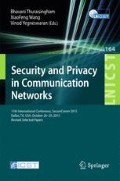Abstract
With the popularity of Android devices, more and more Android malware are manufactured every year. How to filter out malicious app is a serious problem for app markets. In this paper, we propose DroidADDMiner, an efficient and precise system to detect, classify and characterize Android malware. DroidADDMiner is a machine learning based system that extracts features based on data dependency between sensitive APIs. It extracts API data dependence paths embedded in app to construct feature vectors for machine learning. While DroidSIFT [13] also attempts automated detection of Android applications according to data flow analysis, DroidADDMiner can not only reduce the run time but also characterize malware’s behaviors automatically. We implement DroidADDMiner based on FlowDroid [14] and evaluate it using 5648 malware samples and 14280 benign apps. Experiments show that, for malware detection, DroidADDMiner achieves a 98% detection rate, with a 0.3% false positive rate. For malware classification, the accuracy of classifying malicious apps under their proper family labels is 96%. Although performing data flow analysis, most of the experimental samples can be examined in 60 seconds.
Access this chapter
Tax calculation will be finalised at checkout
Purchases are for personal use only
Preview
Unable to display preview. Download preview PDF.
References
iPhone market share shrinks as Android, Windows Phone grow. http://www.cnet.com/news/iphone-market-share-shrinks-as-android-windows-phone-grow/
Mobile threat report 2013 q3. F-Secure Response Labs (2013). https://www.f-secure.com/documents/996508/1030743/Mobile_Threat_Report_Q3_2013.pdf
Symantec enterprise. http://www.symantec.com/security_response/landing/azlisting.jsp
Virustotal. https://www.virustotal.com/
Virusshare. http://virusshare.com/
Ad-Aware. http://www.lavasoft.com/
Xiaomi android market. http://app.mi.com/
Anzhi Android market. http://www.anzhi.com/
Android malware genome project. http://www.malgenomeproject.org/
Arp, D., Spreitzenbarth, M., Hbner, M., Gascon, H., Rieck, K., Siemens, C.: Drebin: effective and explainable detection of android malware in your pocket. In: Proceedings of NDSS, February 2014
Yang, C., Xu, Z., Gu, G., Yegneswaran, V., Porras, P.: DroidMiner: automated mining and characterization of fine-grained malicious behaviors in android applications. In: Kutyłowski, M., Vaidya, J. (eds.) ICAIS 2014, Part I. LNCS, vol. 8712, pp. 163–182. Springer, Heidelberg (2014)
Agrawal, R., Srikant, R.: Fast algorithms for mining association rules in large databases. In: Proceedings of the 20th International Conference on Very Large Data Bases, pp. 641–644. Morgan Kaufmann Publishers Inc. (1994)
Zhang, M., Duan, Y., Yin, H., Zhao, Z.: Semantics-aware android malware classification using weighted contextual API dependency graphs. In: Proceedings of the 2014 ACM SIGSAC Conference on Computer and Communications Security, pp. 1105–1116. ACM, November 2014
Arzt, S., Rasthofer, S., Fritz, C., Bodden, E., Bartel, A., Klein, J., Le Traon, Y., Octeau, D., McDaniel, P.: Flowdroid: precise context, flow, field, object-sensitive and lifecycle-aware taint analysis for android apps. In: Proceedings of the 35th ACM SIGPLAN Conference on Programming Language Design and Implementation, pp. 29. ACM, June 2014
Fritz, C., Arzt, S., Rasthofer, S., Bodden, E., Bartel, A., Klein, J., Le Traon, Y., Octeau, D., McDaniel, P.: Highly precise taint analysis for Android applications. EC SPRIDE, TU Darmstadt, Tech. Rep. (2013)
Lu, L., Li, Z., Wu, Z., Lee, W., Jiang, G.: Chex: statically vetting android apps for component hijacking vulnerabilities. In: Proceedings of the 2012 ACM Conference on Computer and Communications Security, pp. 229–240. ACM, October 2012
Wei, F., Roy, S., Ou, X.: Amandroid: a precise and general inter-component data flow analysis framework for security vetting of android apps. In: Proceedings of the 2014 ACM SIGSAC Conference on Computer and Communications Security, pp. 1329–1341. ACM, November 2014
Horwitz, S., Reps, T., Binkley, D.: Interprocedural slicing using dependence graphs. ACM Transactions on Programming Languages and Systems (TOPLAS) 12(1), 26–60 (1990)
Reps, T., Horwitz, S., Sagiv, M.: Precise interprocedural dataflow analysis via graph reachability. In: Proceedings of the 22nd ACM SIGPLAN-SIGACT Symposium on Principles of Programming Languages, pp. 49–61. ACM, January 1995
Aafer, Y., Du, W., Yin, H.: DroidAPIMiner: mining API-level features for robust malware detection in android. In: Zia, T., Zomaya, A., Varadharajan, V., Mao, M. (eds.) SecureComm 2013. LNICST, vol. 127, pp. 86–103. Springer, Heidelberg (2013)
Au, K.W.Y., Zhou, Y.F., Huang, Z., Lie, D.: Pscout: analyzing the android permission specification. In: Proceedings of the 2012 ACM conference on Computer and communications security, pp. 217–228. ACM, October 2012
Zhou, Y., Jiang, X.: Dissecting android malware: characterization and evolution. In: 2012 IEEE Symposium on Security and Privacy (SP), pp. 95–109. IEEE, May 2012
Rastogi, V., Chen, Y., Jiang, X.: Droidchameleon: evaluating android anti-malware against transformation attacks. In: Proceedings of the 8th ACM SIGSAC Symposium on Information, Computer and Communications Security, pp. 329–334. ACM, May 2013
Zheng, M., Lee, P.P.C., Lui, J.C.S.: ADAM: an automatic and extensible platform to stress test android anti-virus systems. In: Flegel, U., Markatos, E., Robertson, W. (eds.) DIMVA 2012. LNCS, vol. 7591, pp. 82–101. Springer, Heidelberg (2013)
Hall, M., Frank, E., Holmes, G., Pfahringer, B., Reutemann, P., Witten, I.H.: The WEKA data mining software: an update. ACM SIGKDD Explorations Newsletter 11(1), 10–18 (2009)
Author information
Authors and Affiliations
Corresponding author
Editor information
Editors and Affiliations
Rights and permissions
Copyright information
© 2015 Institute for Computer Sciences, Social Informatics and Telecommunications Engineering
About this paper
Cite this paper
Li, Y., Shen, T., Sun, X., Pan, X., Mao, B. (2015). Detection, Classification and Characterization of Android Malware Using API Data Dependency. In: Thuraisingham, B., Wang, X., Yegneswaran, V. (eds) Security and Privacy in Communication Networks. SecureComm 2015. Lecture Notes of the Institute for Computer Sciences, Social Informatics and Telecommunications Engineering, vol 164. Springer, Cham. https://doi.org/10.1007/978-3-319-28865-9_2
Download citation
DOI: https://doi.org/10.1007/978-3-319-28865-9_2
Publisher Name: Springer, Cham
Print ISBN: 978-3-319-28864-2
Online ISBN: 978-3-319-28865-9
eBook Packages: Computer ScienceComputer Science (R0)

